Weekly Arizona COVID-19 Data Report – Dr. Joe Gerald, October 8
Note this forecast page is not the most recent forecast available.
View the most current forecast report
Researcher Analyzes Arizona COVID-19 Spread Models for Decision-Makers
The following information regarding the spread of COVID-19 in Arizona was prepared by Joe Gerald, MD, PhD, a researcher at the Mel and Enid Zuckerman College of Public Health (MEZCOPH) at the University of Arizona. This information has also been reviewed by other MEZCOPH faculty.
This data were obtained from the Arizona Department of Health Services COVID-19 webpage and reflect conditions in Arizona as of October 8, 2021.
This information is intended to help guide our response to the outbreak. It is not intended to predict how this pandemic will evolve. Rather, this model extrapolates what might occur if current conditions remain unchanged. As regional authorities and healthcare providers respond, their actions are expected to mitigate the worst consequences of this pandemic.

COVID-19 Disease Outbreak Forecast
Arizona State and Pima County
Updated October 8, 2021
Disclaimer: This information represents my personal views and not those of The University of Arizona, the Zuckerman College of Public Health, or any other government entity. Any opinions, forecasts, or recommendations should be considered in conjunction with other corroborating and conflicting data. Updates can be accessed at https://publichealth.arizona.edu/news/2021/covid-19-forecast-model.
For the week ending October 3rd, 17133 Arizonans were diagnosed with COVID-19, a 1% decrease from last week’s initial tally of 17229 cases (Figure 1). The current rate, 235 cases per 100K residents per week, is decreasing by 3 cases per 100K residents per week. Case rates remain highest among those 15 – 24 years and lowest among those >65 years, 286 versus 148 cases per 100K residents, respectively (Figure 2a below).
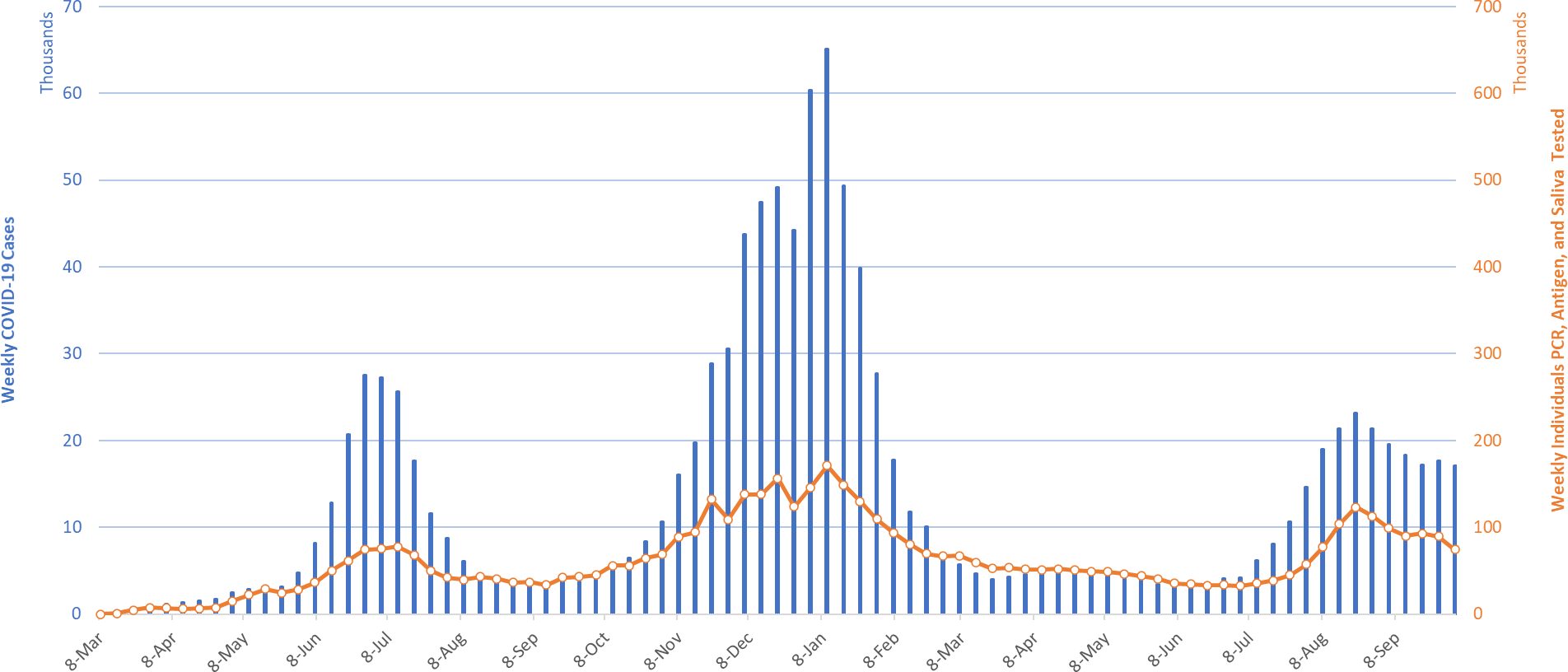
|
Figure 1. Weekly COVID-19 Cases in Arizona and Number of Individuals Undergoing COVID-19 Diagnostic Testing March 1, 2020 – October 3, 2021. |
Arizona continues to experience a high number of cases, hospitalizations, and deaths. With waning vaccine efficacy and a potentially short duration of acquired immunity, herd immunity is not achievable. As winter approaches, more previously vaccinated and previously infected individuals will become susceptible. While these individuals will remain well protected from severe outcomes, they will contribute to community transmission. This means unvaccinated Arizonans will not be able to avoid infection by “free riding” on high levels of community immunity. Their decision to remain unvaccinated carries a much greater risk than getting vaccinated. Hopefully, Merck’s preliminary, promising results of a new antiviral that reduces hospitalization and deaths will be available before the end of winter should waning immunity and seasonality lead to another wave.
Arizona’s national ranking on new cases in the past week has moved up to 20th out of 50 states with the nation’s leaders being Alaska (779), Montana (593), North Dakota (567), Wyoming (546), and West Virginia (495). It was about this time last year that Arizona began its second, most deadly wave. According to the CDC, 62% of Arizona’s adult population is fully vaccinated and another 10% have received one dose. In addition, 10% of those 65+ years have received a third dose booster nationally. The ADHS Vaccine Dashboard shows weekly doses delivered locally have increased markedly to 110K doses per week, many of which presumably being third dose boosters.
Figure 2a shows at least a temporary slowing of improvements among all groups except those 15 – 24 years of age. Worryingly, cases among those 65+ remain quite high despite high levels of vaccination among this group. ASU, MCDPH, and PCHD researchers recently provided strong evidence supporting K – 12 mask mandates; Arizona schools without mandates had 3.5 times the odds of a school outbreak (95%CI 1.8 – 6.9) as compared to those with a mandate. Similar conclusions were reported from county-level data in the US. Mask mandates remain an important component of our multi-dimensional response to slow transmission among school-age children (Figure 2b). The Arizona Supreme Court is expected hear oral arguments on the State’s prohibition of school mask mandates during the first week of November.
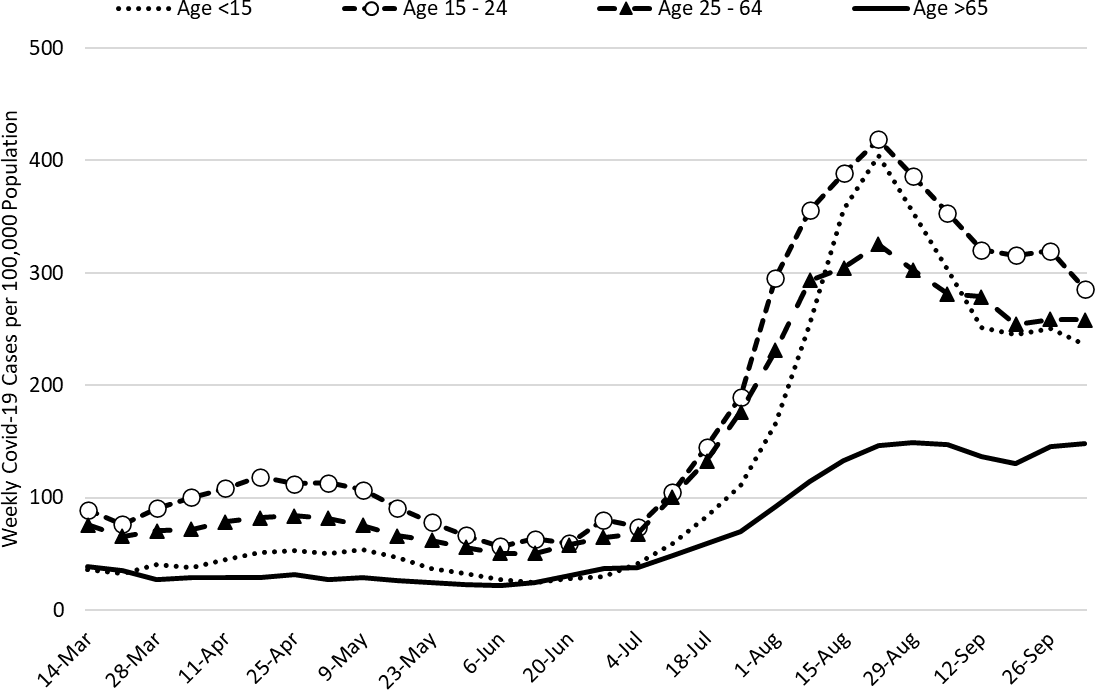
|
Figure 2a. COVID-19 Cases in Arizona by Age Group March 7 – October 3, 2021. |
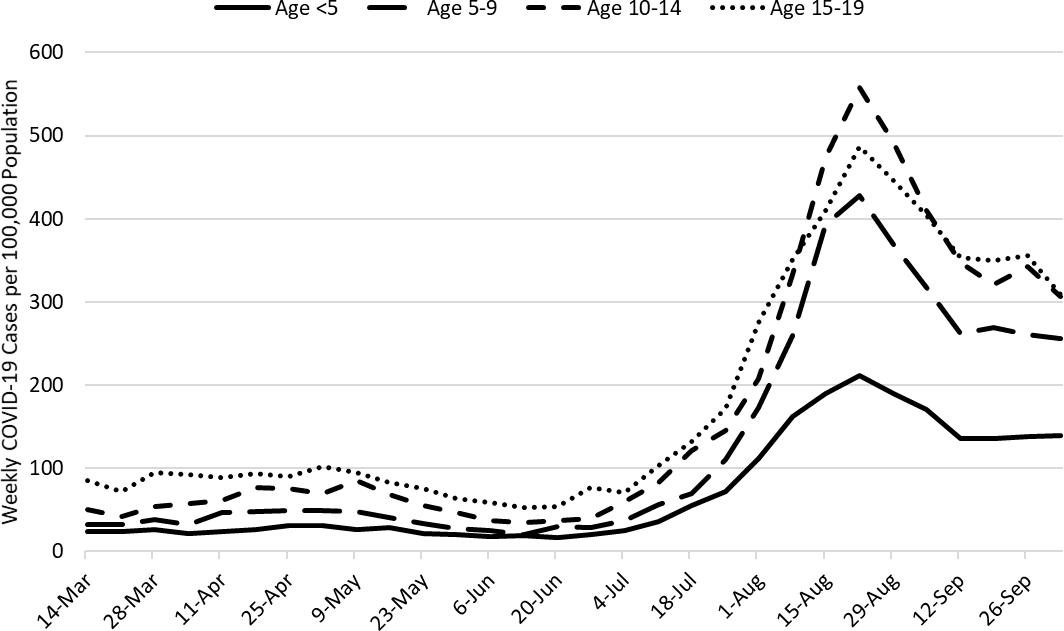
|
Figure 2b. COVID-19 Cases in Arizona among Children by Age Group March 7 – October 3, 2021. |
Comparing school reopening this year (in-person) with last year (virtual), levels of community transmission remains much higher this year than last, particularly among those 15 years (Figure 2c). Higher transmission among those 15 – 24 years associated with university re-openings was almost resolved this time last year (orange bars, ages 15 – 24). Campus outbreaks have been less of an issue this year; after a modest outbreak in September, cases reported on the UA COVID-19 Dashboard have been declining in October on base of steady testing, about 1000 per day. Test positivity is 1% overall and generally 5% at campus health.
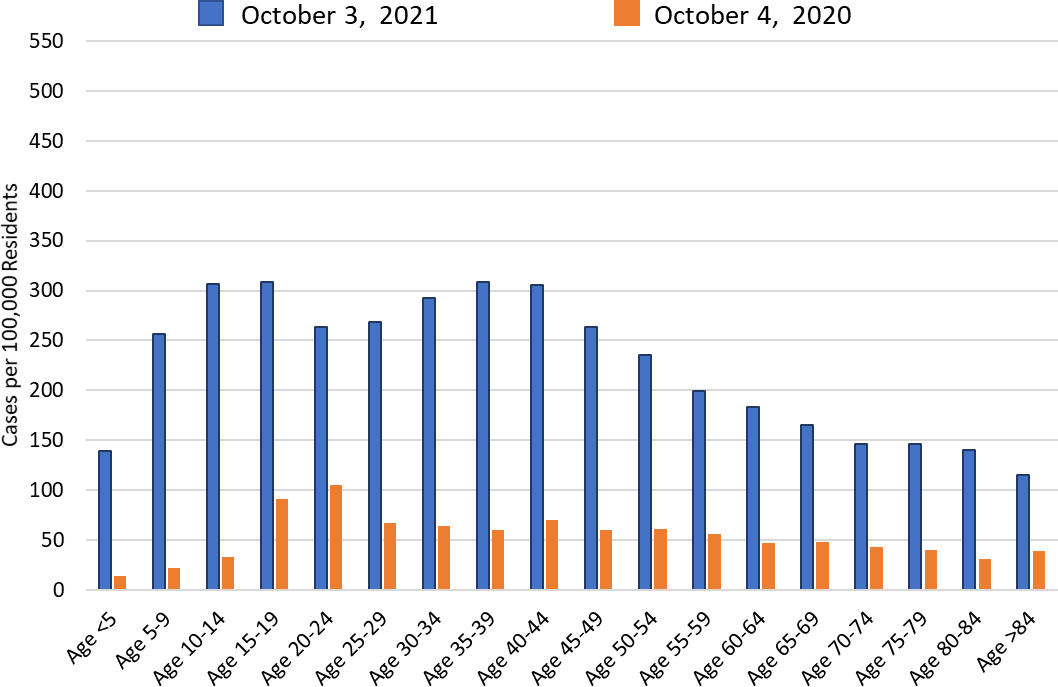
|
Figure 2c. COVID-19 Cases in Arizona by Age Group Week Ending October 4, 2020 versus October 3, 2021. |
Test positivity remains at 23% this week on a smaller base of tests (Figure 3). Testing is inadequate for public health practice and many cases are going undiagnosed. It is unclear how much at-home testing is supplanting clinical testing. Even so, test positivity in the clinical setting remains an important barometer of transmission.
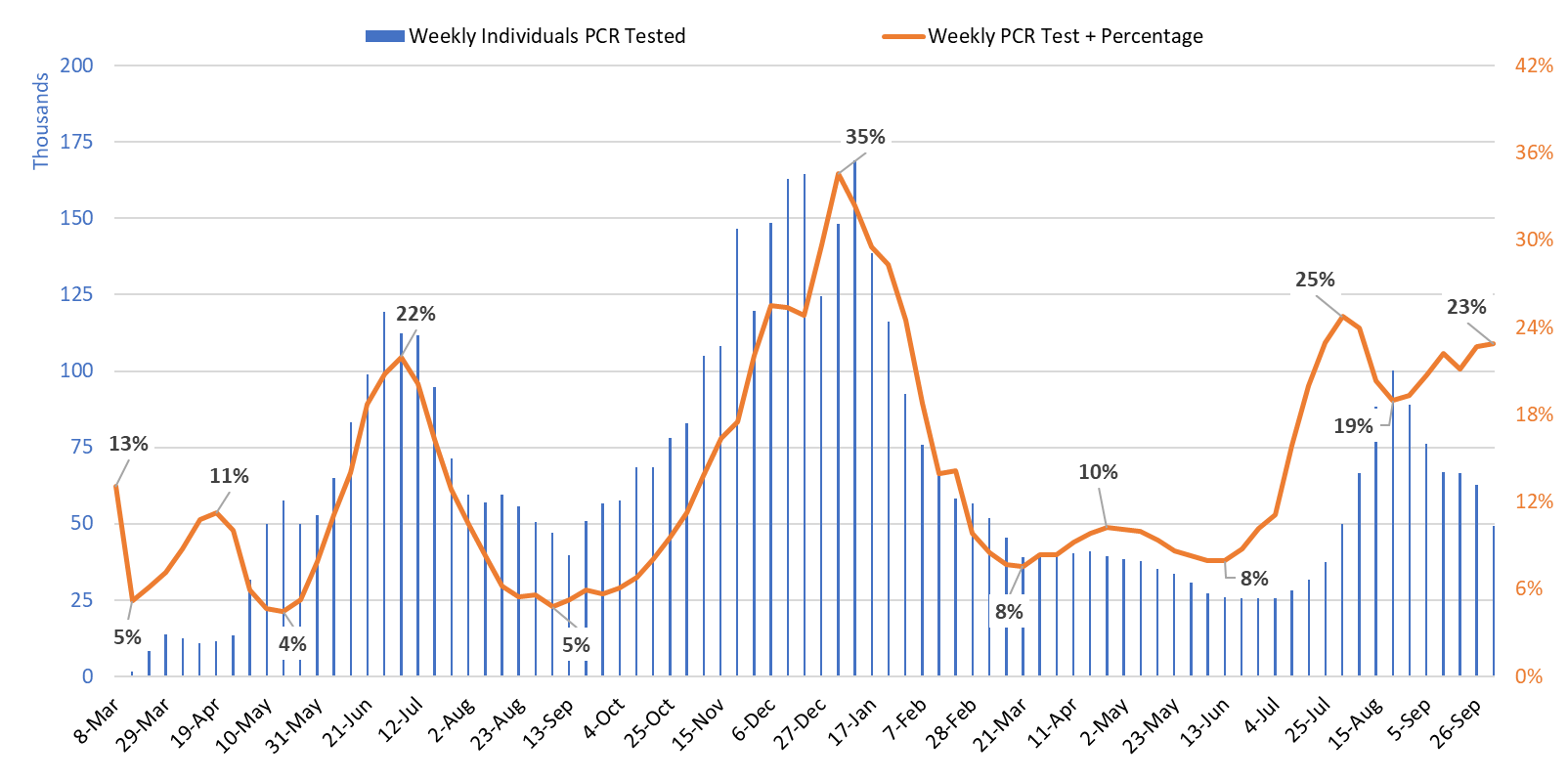
|
Figure 3. Weekly Number of Patients Undergoing Traditional Nasopharyngeal PCR Testing and Associated Percent Positivity March 1, 2020 – October 3, 2021. |
As of October 6th, 1762 (20%) of Arizona’s 8770 general ward beds were occupied by COVID-19 patients, a 0% decrease from last week’s 1768 occupied beds (Figure 4 and Figure 5 Panel A). Another 669 (8%) beds remained available for use. The number of available ward beds is larger than last week’s 631 beds. Four-hundred seventy-seven (477, 27%) of Arizona’s 1774 ICU beds were occupied by COVID-19 patients, a 6% decrease from last week’s 510 occupied beds (Figure 4 and Figure 5 Panel B). An additional 126 (7%) ICU beds remained available for use, fewer than last week’s 138 beds. As a lagging indicator, hospital COVID-19 occupancy is now slowly declining in the general ward and ICU.
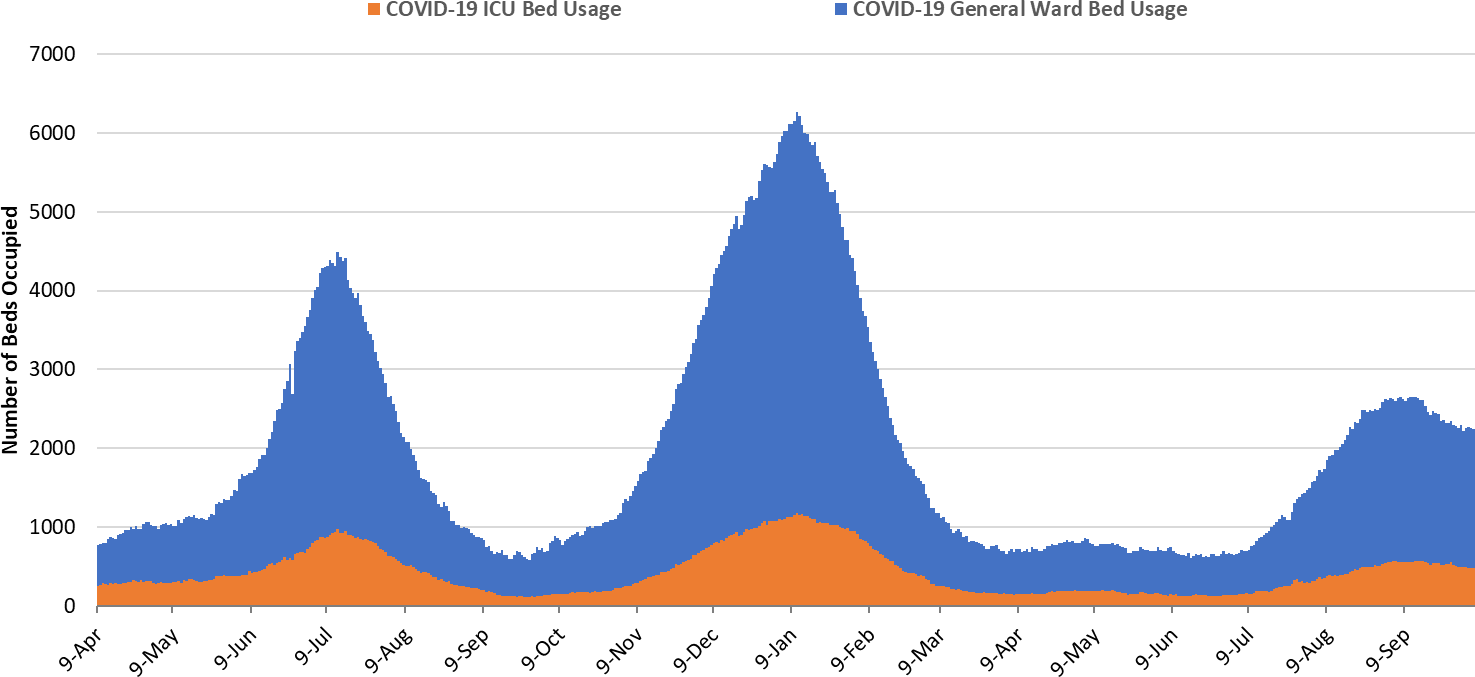
|
Figure 4. Arizona Daily COVID-19 General Ward and ICU Census April 9, 2020 – October 6, 2021. |
While peak occupancy with this third wave never reached levels seen in the prior two, the base of the wave has the potential to be broader. For example, the summer 2020 wave saw 57 days with combined ward and ICU occupancy >2000 patients. The current summer 2021 wave has so far seen 55 days with a combined occupancy >2000 patients. For comparison, the winter 2021 wave say 98 days above 2000 combined occupancy. This persistent base of COVID-19 occupancy will have important implications for hospitals as they attempt to meet the typically high season demands between October and February.
|
Figure 5. COVID-19 Occupancy as a Percent of Listed General Ward (A, left) and ICU (B, right) Capacity in Arizona April 20, 2020 – October 6, 2021. |
Arizona hospital occupancy remains far above seasonal levels. Safety margins, as measured by excess available beds, remain quite low (Figure 6). Because COVID-19 occupancy is improving slowly, hospitals should be prepared for >20% ward occupancy and >25% ICU occupancy for another week or two. The tail of this COVID- 19 surge continues to impact access to healthcare for anyone who becomes critically ill. Staffing shortages continue to impact care making capacity more constrained than these bed numbers reflect.
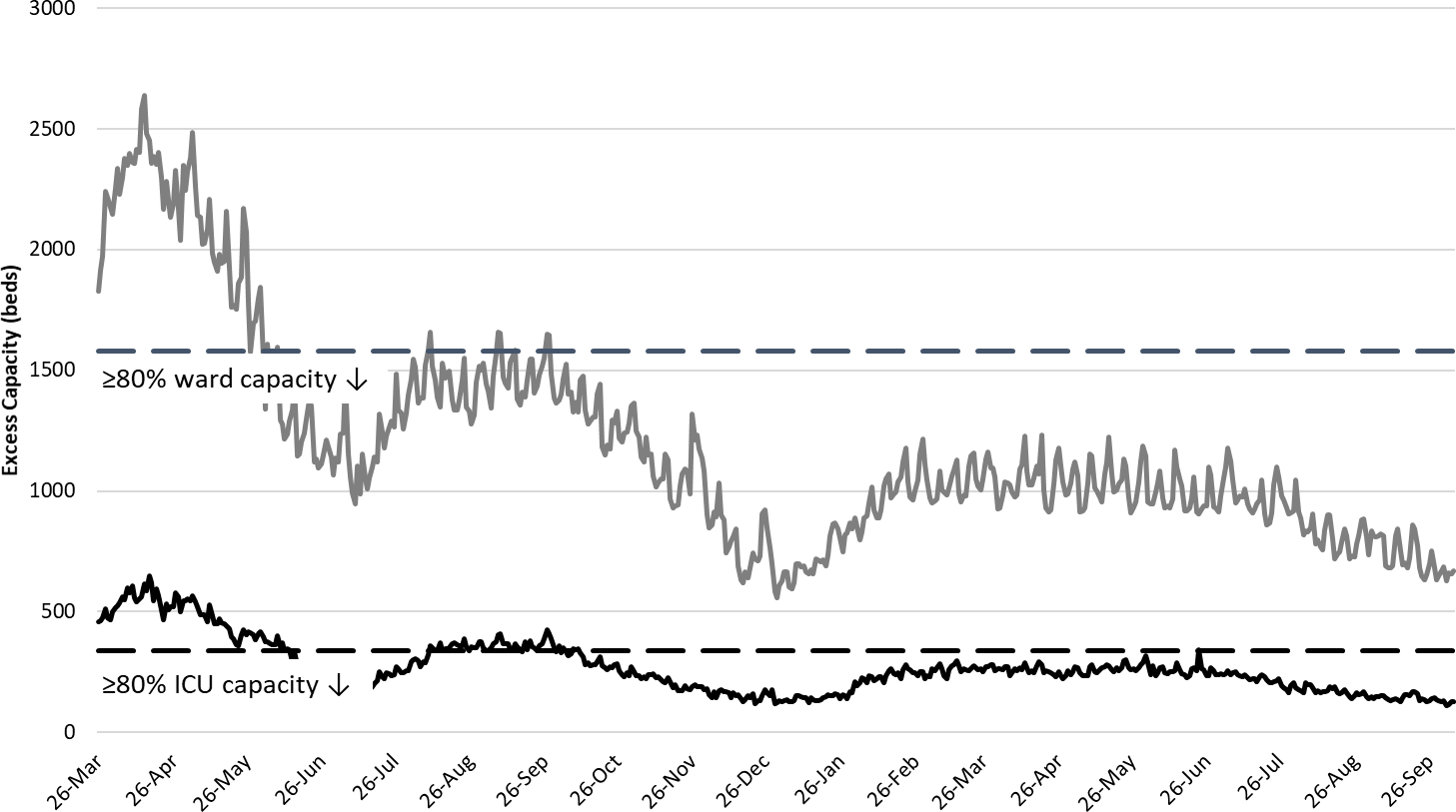
|
Figure 6. Observed Excess Non-Surge General Ward and ICU Capacity in Arizona March 26, 2020 – Oct 6, 2021. |
Arizona has been experiencing >200 COVID-19 deaths per week since August 22nd. The week ending September 5th has so far seen 297 deaths (Figure 7). The week ending September 12th is close behind with 277 recorded deaths. It now almost certain that Arizona will reach 300 deaths per week for the weeks ending September 5th and/or the week ending September 12th with declines following soon thereafter.
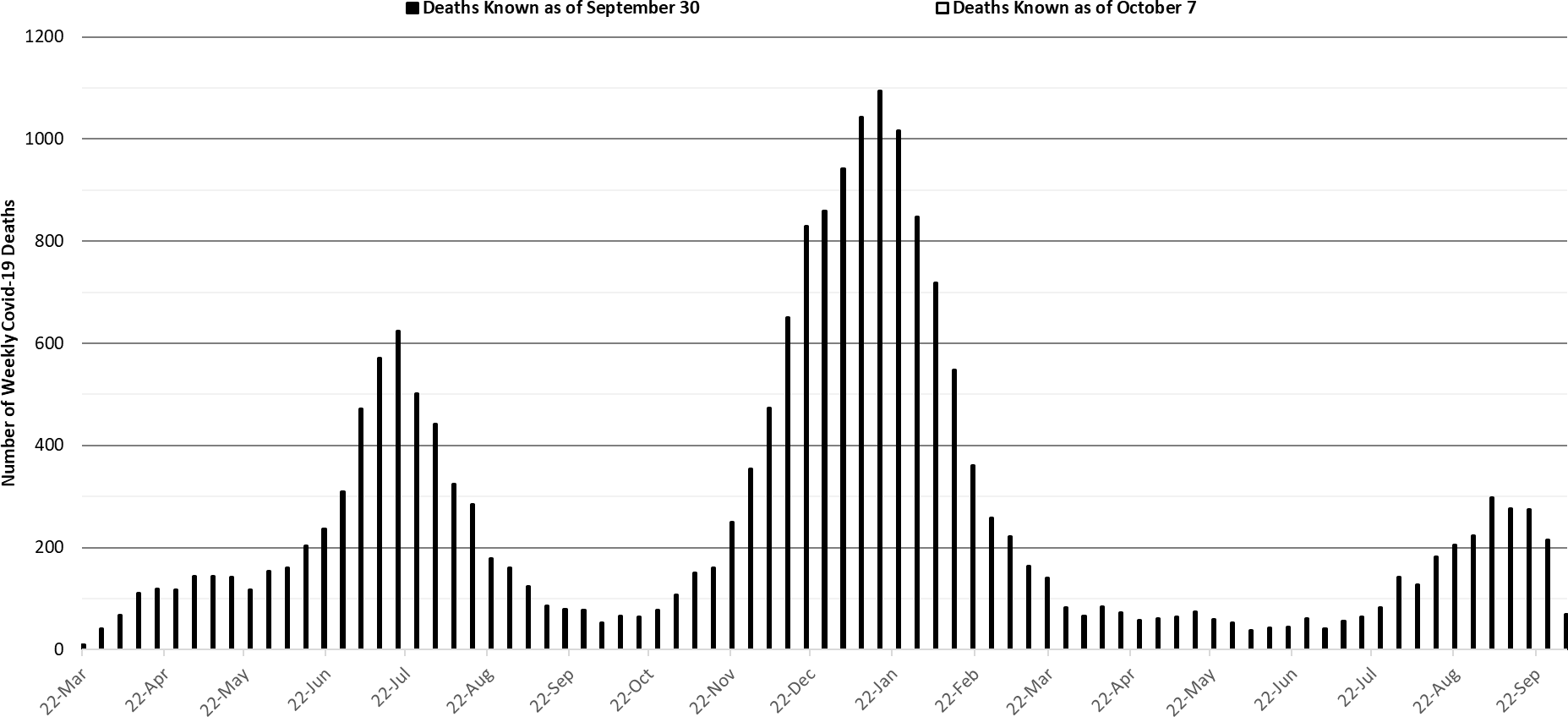
|
Figure 7. Weekly Arizona COVID-19 Deaths March 16, 2020 – October 3, 2021. |
Pima County Outlook
For the week ending October 3rd, 1888 Pima County residents were diagnosed with COVID-19 an 11% increase from last week’s initial tally (Figure 8).
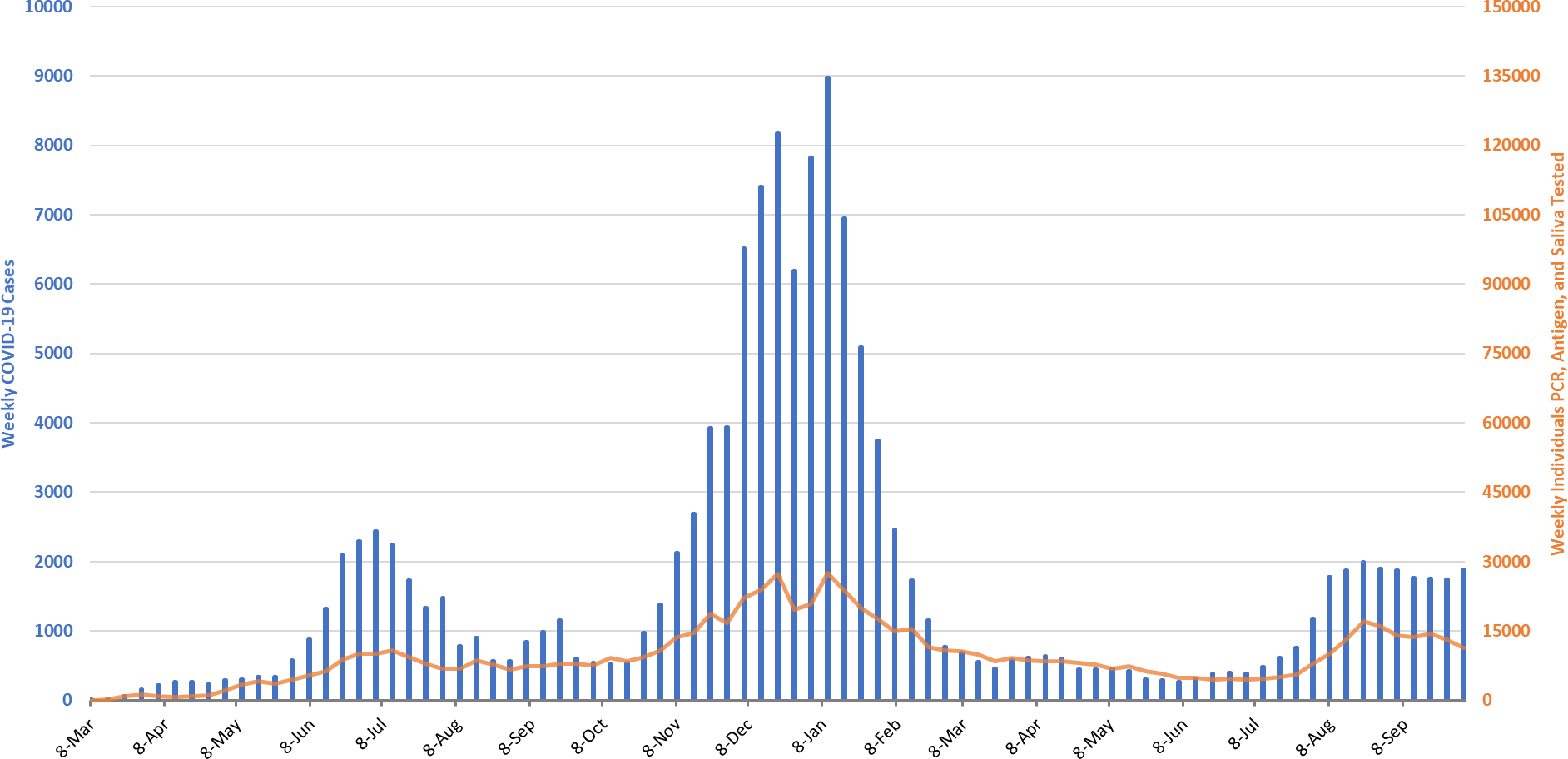
|
Figure 8. Weekly COVID-19 Cases in Pima County and Number of Individuals Undergoing COVID-19 Diagnostic Testing March 1, 2020 – October 3, 2021. |
New cases are being diagnosed at a rate of 180 cases per 100K residents per week and this rate is increasing by 10 cases per 100K residents per week. Trends across the various age groups appear in Figure 9.
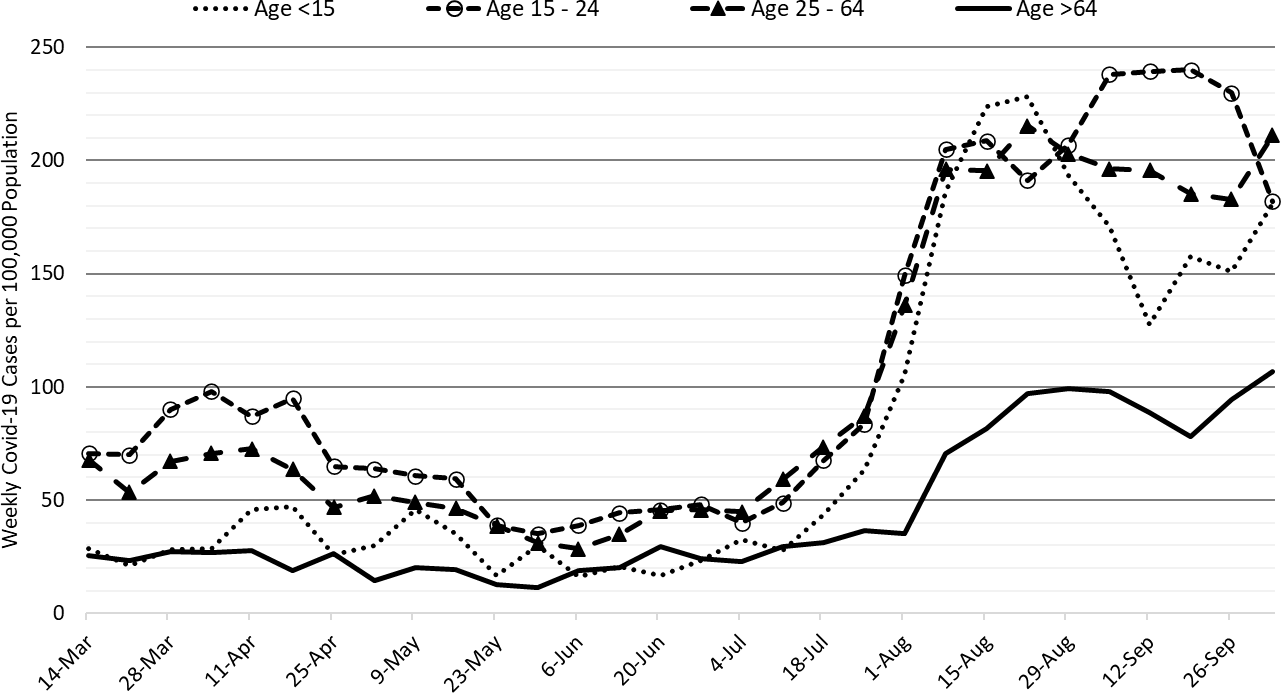
|
Figure 9. COVID-19 Cases in Pima County by Age Group March 7, 2020 – October 3, 2021. |
Summary
- Arizona continues to experience high levels of community transmission with case rates now plateaued instead of consistently improving. Test positivity remains stubbornly high reminding us that test capacity, accessibility, and/or uptake is inadequate to meet public health needs. Plateauing, particularly among older, highly vaccinated groups, serves as a warning that major behavioral shifts or waning immunity could result in future increases.
- As of October 3rd, new cases were being diagnosed at a rate of 235 cases per 100K residents per week. The rate was decreasing by 3 cases per 100K residents per week.
- With waning vaccine efficacy and a potentially short duration of acquired immunity, the unvaccinated cannot “free ride” on high levels of community immunity. Instead, they will almost certainly become infected. This means that persistently high levels of transmission, and more importantly hospitalizations, are possible for an extended time until the supply of unvaccinated, previously uninfected adults is exhausted.
- Vaccination remains the most important public health priority to reduce transmission and severe illness; however, mask mandates, restrictions on indoor gatherings, and targeted business mitigations are still needed to reduce/control transmission in the short-run with the primary goal being to prevent overwhelming our critical care facilities and reducing pressure for vaccine-escape variants.
- CDC recommendations for third dose booster shots can be found here: https://www.cdc.gov/coronavirus/2019-ncov/vaccines/booster-shot.html
- Third dose boosters induce similar symptoms to those of the second shot: https://www.cdc.gov/mmwr/volumes/70/wr/mm7039e4.htm?s_cid=mm7039e4_w
- Recent reports indicate that vaccine immunity to infection falls against the Delta variant by 6 months. Accordingly, it is becoming more likely that the Delta variant could sustain forward transmission even in a highly vaccinated community without additional boosters or other non- pharmacologic interventions. Because immunity against severe illness is much longer lasting, infections among the vaccinated will have less impact on individuals and communities. This provides hope of an end-game where we can (mostly) live with SARS-CoV-2.
- https://www.thelancet.com/journals/lancet/article/PIIS0140-6736(21)02183-8/fulltext
- https://www.nejm.org/doi/full/10.1056/NEJMoa2114583
- https://www.nejm.org/doi/full/10.1056/NEJMoa2114114
- https://www.nejm.org/doi/full/10.1056/NEJMoa2110362
- https://www.thelancet.com/journals/lanres/article/PIIS2213-2600(21)00380-5/fulltext
- https://www.nejm.org/doi/full/10.1056/NEJMoa2113017
- CDC recommendations for third dose booster shots can be found here: https://www.cdc.gov/coronavirus/2019-ncov/vaccines/booster-shot.html
- COVID-19 hospital occupancy is slowly improving. Nevertheless, occupancy is likely to exceed 20% of all beds in the general ward and 25% of beds in the ICU for another week or so. Access to care will remain restricted; therefore, delays in elective procedures will persist inf the face of staff shortages in inpatient and outpatient settings.
- Merck announced preliminary, promising results of a new antiviral to reduce severe illness: https://www.reuters.com/business/healthcare-pharmaceuticals/mercks-covid-19-pill-cuts-risk-death-hospitalization-by-50-study-2021-10-01/.
- Weekly COVID-19 deaths now exceed 200 per week and will almost certainly reach 300 for the week ending September 5th and perhaps September 12th too before receding.
Forecast reports to date, available as PDFs
Download PDF to view additional charts of Arizona counties, available in appendix of report.
2020 Reports
Based on what we know now about this pandemic, we support guidelines for social distancing to slow the spread of the virus and urge everyone to follow the recommendations provided by the Centers for Disease Control and Prevention (CDC) to protect yourself, your family, your neighbors, and your employees. Please heed the recommendations as provided by the CDC.
COVID covid coronavirus virus covid19 corona forecast model

